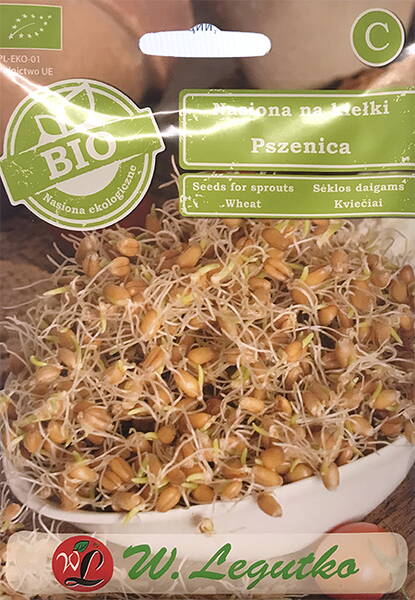Ex Tax: 1.29€
A traditional healthy food product recognized all over the world - eating wheat sprouts normalizes the functioning of many body systems at any age.
We offer the wheat variety most suitable for sprouting: soft, low in gluten.
It is known that during germination, the content of basic nutrients, vitamins, macro- and microelements in wheat grain changes. Vitamins are intensively synthesized, the amount of macro- and microelements increases.
When seeds germinate, the following increases:
- the amount of vitamin C - from 1.07 mg / 100 g to 8.4 mg / 100 g (30 g of wheat germ corresponds to the content of vitamin C in four glasses of orange juice)
- the total content of antioxidants - from 24 mg / 100 g to 275 mg / 100 g.
Nutritional value of wheat germ:
- a complex of vitamins (C, E, D, K, P, group B, as well as folic acid, biotin, carotene)
- a source of minerals (iodine, selenium, vanadium, copper, sulfur, fluorine, silicon, molybdenum, cobalt, manganese, chromium, zinc, iron, magnesium, phosphorus, calcium, potassium)
- contains simple sugars, amino acids, fatty acids and antioxidants
- in sprouted wheat, the total amount of vitamin C is increased by 8 times, and the total content of antioxidants is increased by 12 times in comparison with the grain at rest.
Medicinal value.
Wheat grains for germination, and especially their sprouts, actively nourish the body with energy, stimulating and strengthening the body's defenses, boosting immunity, treating liver diseases, and guaranteeing healthy hair and healthy skin. The fortifying properties of sprouted wheat are used to treat wounds, edema, and tumors.
Sprouted wheat is also very useful for diseases of the prostate.
It normalizes urination, cleanses the bladder, kidneys, relieves pain during intestinal ulcers.
Wheat for germination is recommended in the treatment of chronic gastritis and colitis, with symptoms of dysbiosis, complex treatment of the duodenum and stomach ulcers.
Its seedlings are also shown in the treatment of diabetes mellitus, obesity and allergies.
With a beneficial effect on the functioning of the nervous and circulatory systems, they alleviate the effects of stress and slow down the aging process.
Optimum sprout length: 0.2 - 0.5 cm, but it is also possible to grow long sprouts 5 - 15 cm (microgreens).
Storage: refrigerated for up to 3 days.
Attention: wheat seedlings are contraindicated in case of acute intolerance to gluten, which is contained in them.
Instructions for use: pour the amount reguired in to a bowl of water at room temperature and allow them to soak for 8-10 hours.
Subsequently place the seeds into your sprouter covering no more than 25% of the tray as the seeds will in size. Put the sprouter in a light spot at room temperature changing the water 2-3 times a day.
The sprouts will be ready in about 6-10 days. Cut the sprouts about the seed and wash them before eating. They will keep in the fridge for up to a week (8-10 days).
* Growing microgreens hydroponically.
Hydroponics is a method of growing plants without soil, instead using mineral solutions of water, as an option - using a substrate, which serves as a support for plants in hydroponics. Microgreens are a very nutritious crop that contains a large number of vitamins and minerals. Thanks to hydroponics, you can control the concentration of nutrients in the solution, which allows you to get healthier and more nutritious products.
Growing microgreens hydroponically significantly saves space and resources. For example, to grow one kilogram of microgreens hydroponically, you will need only 10% of water compared to traditional growing methods.
It is also worth mentioning that microgreens in this case are grown without the use of soil, which simplifies the process of caring for the crop and avoids problems associated with soil contamination or plant diseases. Some types of microgreens grow better without soil, for example, wheat, cabbage and kohlrabi prefer to germinate hydroponically and show a better yield than if they were grown in soil.
Growing microgreens hydroponically may seem like a complicated process, but with the right instructions and approach, it can be easy and fun.
Technology for growing microgreens at home using hydroponics:
1. Prepare the water.
For ideal results in hydroponics, it is necessary to maintain the pH of the water in the range of 5.5 to 6.5.
Test your water with litmus paper and, if necessary, adjust its acidity.
Most hydroponic fertilizers already contain substances that automatically adjust the pH to the optimal level (instructions for adding nutrients to water are indicated on each fertilizer package).
In our case, since we are growing microgreens, we will not need a lot of fertilizers. If you use tap water, it is advisable to let it settle for 24 hours (during this time, the chlorine will evaporate).
2. Prepare the substrate.
Fill the substrate with the nutrient solution you have prepared and wait until it is completely saturated. Place the saturated substrate in a container.
3. Sow the seeds.
Distribute the seeds evenly over the entire surface of the substrate. For proper planting of each type of microgreens, it is necessary to use a certain seed density.
(For example, a 5 gram bag of mustard is enough to sow a tray measuring 26x10 cm, while for radishes the same bag will only be needed for an area of 16x10 cm).
After sowing, it is recommended to spray the seeds with a sprayer (use either purified water or a nutrient solution for this purpose).
4. Cover the seeds.
The best option is to cover your mini garden with a light-proof lid. Even another tray turned upside down will do for this.
5. Germination and seedlings.
For best results, it is recommended to grow microgreens in complete darkness. The tray should be opened for misting about once every 12 hours. It is important to remember that germinating seeds and young seedlings should remain in the dark for the first 3-5 days, depending on the type of microgreens.
6. Actions during the active growth stage.
After about 5 days, your microgreens will start to grow well, and you can remove the lid to expose the tray to lighting. From this point on, you can water them by adding a small amount of water directly into the tray, rather than misting. For watering, you can use pH-balanced water or continue using a weak hydroponic solution. It is recommended to reduce the concentration of the solution to 1/4 of its original concentration for continuous watering. If you do not have a special lamp, then the tray where the microgreens are growing must be regularly turned over to face the natural light, otherwise you may encounter phototropism, i.e. the plant will turn around and stretch towards the light.
7. Harvesting.
After 10-12 days, most varieties of microgreens will be ready for harvesting. When harvesting microgreens grown without soil, cut the plants at the base of the stems using sharp scissors. After harvesting, the microgreens need to be rinsed under cold water. Now you can enjoy the taste and aroma. After harvesting the first batch of the crop, the roots are thrown away, the tray is washed and you can sow new microgreens.












